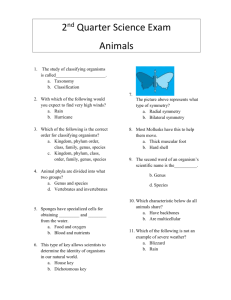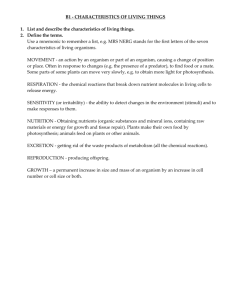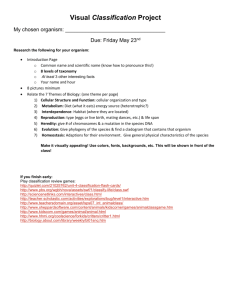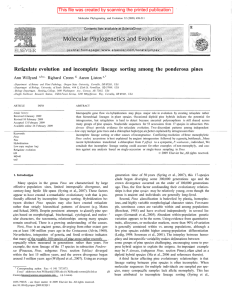Chapter 1 Review
advertisement
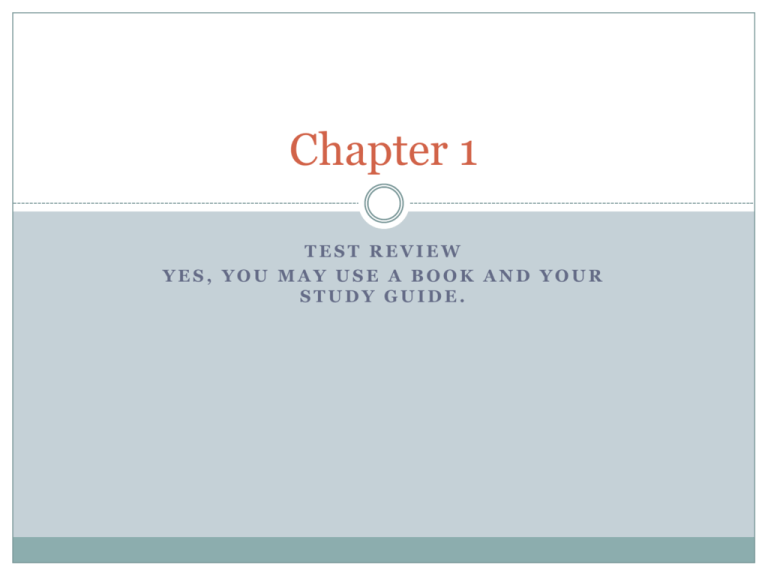
Chapter 1 TEST REVIEW YES, YOU MAY USE A BOOK AND YOUR STUDY GUIDE. Vocabulary THE FOLLOWING ARE DEFINITIONS. PROVIDE THE CORRECT WORD FOR THE FOLLOWING DEFINITIONS. 1 POINT FOR EACH CORRECT ANSWER. condition tested in a scientific experiment variable a combining form meaning “ten” deca explanation of things or events based on many observations theory standard used to compare with outcome of the test control a variable in a functional relation whose value is determined by the values assumed by other variables in the relation ( is measureable) dependent variable a statement about how things work in nature law the evolutionary history of an organism phylogeny two word naming system based on phylogeny binomial nomenclature the theory that living things come from non-living things spontaneous generation the theory that living things comes from other living things biogenesis a variable that is intentionally changed to observe its effect on the dependent variable independent variable the smallest unit of an organism that carries out the functions of life cell keeping proper internal conditions no matter what external conditions are homeostasis living thing organism changes that living organisms undergo as they grow development A combining form meaning “hundredth” or “hundred” centi anything an organism reacts to stimulus reaction of an organism to a stimulus response smallest unit of organisms that carries on life functions cell characteristic of an organism that helps it to survive in its environment adaptation organized problemsolving procedure in science scientific methods what is being tested in an experiment variable combining form meaning “thousand” kilo standard used to compare with the outcome of a test control the maintenance of steady conditions inside an organism homeostasis True or False 1 POINT FOR GETTING T/F ANSWER CORRECT. 1 POINT FOR REPLACING THE FALSE ANSWER WITH THE CORRECT ANSWER. Any living thing is called an organism. true The smallest unit of a living thing that carries on the function of life is called an organ. False - cell Anything that causes some change in an organism is called a stimulus. True The energy used by most organisms comes directly or indirectly from the Moon. False – the Sun Organisms do not change across time. False - do All living things reproduce. True Fill in the Blank EACH QUESTION IS WORTH 1 POINT THE ANSWER MAY BE MORE THAN 1 WORD. In the 1920s, a Russian scientist named _____ suggested that Earth’s early atmosphere was composed of ammonia, hydrogen, methane, and water vapor. Alexander Oparin Alexander Oparin speculated that these gases could have combined to form more complex compounds found in ______. living things In the 1950s, two American scientists named _____ and Harold Urey set up an experiment to test Oparin’s hypothesis. Stanley Miller Miller and Urey sent electric currents through the gases and found that material found in cells, such as _____, formed. amino acids Short answer Questions 5 POINTS EACH ANSWER MUST HAVE MAIN IDEA OF THE TOPIC. DOESN’T HAVE TO HAVE EXACT WORDING. List 5 characteristics of all living things. Living Things are: 1. organized 2. respond to stimuli 3. use energy 4. grow and develop 5. reproduce What does phylogeny have to do with evolution? Phylogeny is the evolutionary history of an organism, or how it has changed over time. It is the basis for much of modern classification. Contrast a kingdom and a species. A kingdom is the first, and largest, category in the modern system of classification. A species is the smallest classification category. Contrast the two words used in binomial nomenclature. The first word identifies the genus of the organism. The second word of the name might tell you something about the organism, such as what it looks like or who discovered it. What makes something a dichotomous key? A dichotomous key is a detailed list of identifying characteristics that includes scientific names. Dichotomous keys are arranged in steps with two descriptive statements at each step. Pinus banksiana Pinus contorta Pinus resinosa Pinus virginiana What do these trees have in common? They all belong to the genus Pinus. Pinus banksiana Pinus contorta Pinus resinosa Pinus virginiana What can you infer is the common name for this type of tree? The common name is pine tree. Where might you expect to find Pinus virginiana in abundance? You might find it in Virginia. Scientific Method 10 POINT QUESTION MUST BE IN ORDER List the 7 steps your textbooks gives of the Scientific Method 1. 2. 3. 4. 5. 6. 7. state the problem gather information about the problem form a hypothesis perform an experiment to test the hypothesis analyze the data draw a conclusion report results Bonus Question LAST QUESTION 10 POINT QUESTION What is Miss Byrd’s favorite color? green
